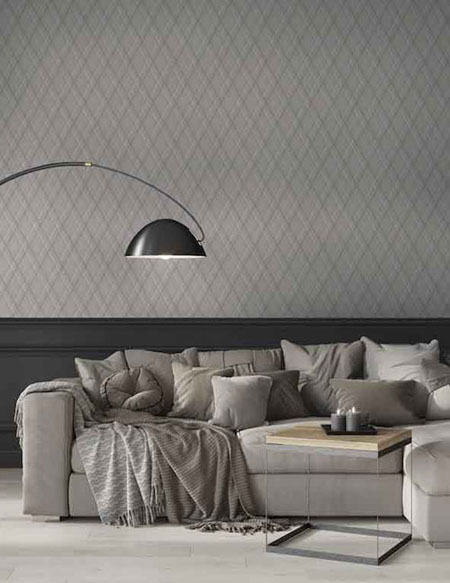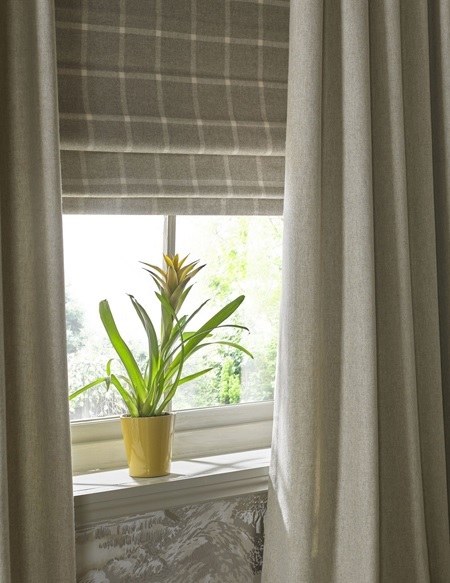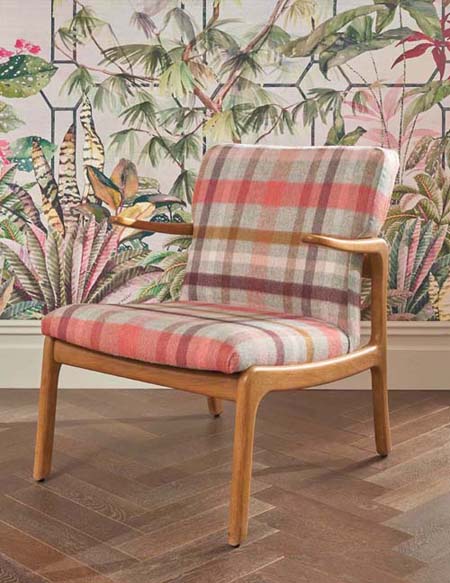Tartan, plaid, and check are classic emblems of style and taste, suitable for a wide variety of interior spaces. They aren't just for ski chalets and highland retreats. However, there is often a lot of confusion surrounding these terms because there are commonalities. All three consist of straight horizontal and vertical lines which intersect to form a pattern. We explore the versatility of these timeless patterns…
Tartan
Tartan designs consist of multiple lines running horizontally and vertically. The pattern of lines running vertically will be replicated exactly on the horizontal axis, and will often result in new shades where they overlap.
Tartan is most commonly associated with Scotland, but its origins are actually thought to lie in Central Europe. There, ancient Celtic populations produced textiles bearing this pattern. It did not appear in Scotland until the 17th century, when it was used to distinguish inhabitants from different regions.
Plaid
The term plaid (pronounced ‘plad’) is from the Gaelic ‘plaide’ meaning ‘blanket’. It originally referred to a heavyweight piece of cloth or cloak used to keep warm during the Scottish winters. Plaids were typically woven with a tartan pattern, which is why the terms are often confused.
Nowadays, the term plaid is also used to refer to a design in which vertical stripes do not always match the horizontal ones, as a tartan does. The result is a more complex pattern. It usually features additional colours or shades.
Check
Checks are far easier to define: they have a symmetrical design of thick or thin lines. These intersect to form squares of equal size. There are various different types of check including gingham and windowpane.
What about tweed?
Tweed is a thick material made from wool with a textured, sometimes rough surface. Tweed materials often have tartan, plaid or check patterns and so are sometimes referred to by these terms.
Which One Should I Choose?
Tartans and plaids are often considered more traditional patterns due to their heritage. They are therefore seen in country houses or cottages.
Due to their less complex design, checks are usually chosen when more subtlety is required. These delicate designs are ideal for contemporary apartments or simpler spaces.
That being said, the scale of the design and colour palette can turn a seemingly traditional pattern on its head. It's a good idea to keep your options open and consider all three when decorating!
Designer Tip: The terms 'tartan,' 'plaid' and 'check' are often used interchangeably by design houses. On our website you may see a design which looks like tartan but is labelled as being a plaid or vice versa.
Five Ways to Style Tartans, Checks and Plaids...
1. Cool and Calm
The focus on home as a place of retreat has seen a range of customers decorating with more pastel colours. Tartans and plaids especially are often viewed as particularly heavy patterns, but a soothing colour palette can alleviate this. Soft shades of duck egg, baby blue, grey and off-white will maximise light and create an airy feel in your home.
Top tip: To keep things subtle, look for designs with a washed out or faded quality. The pattern will be far more manageable and will help to soften other features of the room.
2) Cosy and Warm
Natural shades of honey, beige, cream and olive work to promote the rural connotations of tartan, plaid and check. This allows you to create a warm and inviting space with a relaxed feel.
It’s a palette that’s easy to build on. Add lush foliage for a more spring-like feeling. Alternatively, make it more autumnal by bringing in dark brown or aubergine tones.
Top tip: Break up tartans, checks and plaids with plain furnishings, painted walls or a subtly striped fabric. The criss-crossing lines of these patterns can easily blend into one another and become too much. A plain surface will create more of a contrast and allow their beauty to truly stand out.
3) Moody Blues
Dark blue is one of the more traditional shades for tartans, plaids and checks to be produced in. It’s no wonder they look so at home together. A dramatic blue palette featuring these designs is ideal for a teenage bedroom, modern study or a smart living space with a masculine edge.
Top tip: When mixing in other motifs, choose a secondary colour from your tartan, plaid or check design. This may include matching with a tribal, ethnic or floral print. Lively copper and fuchsia tones are particularly adept at balancing the moodiness of dark blue.
4) Contrasting and Colourful
Any preconceptions of tartans, plaids and checks being old-fashioned or boring will be firmly banished by an eye-catching scheme featuring chartreuse, black and grey. This eclectic palette is great for drawing attention to the bold and graphic nature of these designs. It can be muted by using pastel hues or accentuated through darker, more saturated shades.
Top tip: The linear nature of tartans, checks and plaids lends itself well to modern, angular furniture. A bold statement can be made by applying an especially busy fabric to a paired back sofa or footstool design.
5) The Royal Treatment
Rich, jewel-like colours such as red and royal purple are seriously on trend at the moment. It goes without saying that tartans, plaids and checks are suited to rich red tones. The addition of deep purple hues and occasional pops of teal or turquoise will add a unique edge. They also look especially good in the form of velvet or wool fabrics.
Top tip: Think outside the box with these bold shades. Try a wall panel or set of dining chairs in an otherwise plain space for head-turning results.
You Might Also Enjoy Reading...


Feel the Benefits of Wool
Whether its as a durable upholstery fabric to keep your furniture looking new for longer, or creating stunning curtains and home accessories that keep you warm through the winter month, here's five reasons why we think that you should try it for yourself...
- paypal
- visa
- mastercard
- amex



















